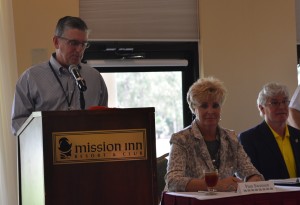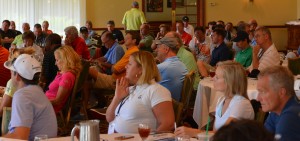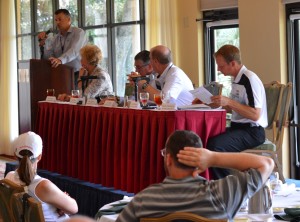By Richard Lord
While there’s been much consternation over golf’s downturn and many doom-and-gloom predictions about its future, The “Growth of the Game from the Trenches Up” panel at the 25th Anniversary ING Spring Conference May 31-June 4 at Mission Inn Resort provided a clear vision of what is needed and what some organizations are doing to get golf out of the rough and back in the fairway.
The panelists’ organizations are indeed working “from the trenches up” in taking varied approaches to attract segments of our society that have either been largely ignored or approached improperly. Among those are juniors, women, Wounded Warriors and other challenged individuals.
Here are some key points made by the speakers.
JOHN JOHNSON, Director of Marketing, SNAG Golf.
SNAG — Starting New At Golf — is taking an approach similar to that taken by US Youth Soccer as it went from having 103,432 registered players in 1974 to more than three million by 2000.
“They had a master plan,” Johnson said. “They started by getting soccer taught in physical ed classes in schools, then they moved to parks with adaptive fields (based on age and skill levels).
In the 1980s and 1990s, Johnson said, a staggering 100,000 soccer fields were built in the U.S. thanks to that master plan.
“Golf hasn’t been taught in the schools and you can’t tee it up in a park,” he said. “We take kids directly to the course and they shouldn’t be there.”
So, with age-appropriate specialized equipment and proven programming to teach the four basic shots of golf in a fun and systematic way, SNAG is doing what soccer did by starting programs in schools, graduating to play and competition in the parks, and after that, on to the golf course.
“Then they can move to courses having learned the skills and having grown a passion for the game,” Johnson said.
The Midwest PGA Section started a SNAG-A-School initiative that has grown from 3,000 to 250,000 kids from ages 5-8 being taught in schools in only three years. The section pros instruct and certify the teachers to teach the game to their students.
“If we get all 41 PGA sections to start the program we could expose 10 million kids to the game,” Johnson said. “I believe we can and will grow the game this way. We need to grab the kids early.”
PAM SWENSEN, CEO of the Executive Women’s Golf Association.
The numbers suggest that golf hasn’t done nearly enough to attract potential female golfers.
“Women are only 20 percent of those involved in golf,” Swensen said. “We need to roll out the green carpet and work on making courses more accessible to women.”
The EWGA is certainly doing their part to make that happen.
“We try to bring women together in a non-intimidating environment,” she said. “We want women to take up the game and to know they you can have lots of fun and become a part of a community. The “E” in EWGA stands for enrichment.”
The EWGA, which has more than 14,000 members and has connected with more than 100,000 women since its founding in 1991, is involved in a host of initiatives to attract women to the game.
The organization has just started its first student chapter at Maryland Eastern Shore, a historically black university that also offers a PGA Golf Management program. EWGA hopes to add chapters at other schools.
“We’re excited about it,” Swensen said. “It brings diversity to our association.”
They have also launched a six-week Grads to Golf program for MBA students at the University of Tennessee and plan to add the program at other schools.
“Many said they didn’t have an interest and were naysayers. They were a little reluctant, but they are believers today,” Swensen said.
A new EWGA website, GolfforHer.com, offers a complete resource depository of golf activities for new, recreational and competitive golfers.
“Golf Inc. named it one of the top 10 trends in golf,” Swensen said.
MIKE TINKEY, Deputy Chief Executive Director, National Golf Course Owners Association.
Tinkey echoed some of the sentiments offered by Johnson and Swensen.
“We must meet people at the door and start with a welcoming attitude,” Tinkey said. “We can’t be don’t, don’t, don’t. It has to be yes, yes, yes.”
Tinkey is encouraged by a number of programs, many of which have resulted from the collaboration between organizations who are part of Golf 20/20, including Drive, Chip and Putt, Golf Get Ready, LPGA/USGA Girls Golf, and PGA Junior League Golf. He also praised SNAG and The First Tee for their work with young people.
Tinkey pointed to what he referred to as “new incubators” for the game that should be embraced including Top Golf facilities, Footgolf, Fling Golf and Speed Golf.
“Footgolf is a home run for golf operators,” he said. “It’s profit for the course and it can segue over to golf. Fling Golf is like lacrosse. It gets kids on the golf course doing something they know.”
That being said, making traditional golf grow is still job No. 1.
“We need to make it so people can have instant success,” Tinkey said. “We must make people feel at home and offer more playing opportunities.”
KEVIN UNTERREINER, Founder, TwinCitiesgolf.com
Unterreiner, whose “Hack to Jack” golf reality series has become an internet sensation, discovered quickly as he attempted to run golf tournaments that the best tool at his disposal was social media.
“I didn’t have a way to communicate with golfers,” he said. “It’s hard to start a golf business. I learned that you need to have the internet and social media to grow it. Everything is online today.”
Unterreiner still uses traditional advertising, but not in a traditional way.
“You need to use traditional advertising to drive golfers to your website to stay connected,” he said.
Unterreiner, who has run more than 1,000 golf events since 1998, offered a quick picture of what he called “the big six” social media tools. They are Facebook (75 percent information, 25 percent sales), Twitter (younger demographic, its today’s morning newspaper), YouTube (world’s No. 2 search engine; put up videos), Instagram (younger demographic) and Linked In (it’s the new resume).
On your website, Unterreiner explained, you must inform and entertain, interact with those visiting your site and drive sales.
“Eighty-three percent of those who use the Internet have bought online, so build up your e-mail list,” he said.
And most of all, he added, you must be attentive to your site.
“The mistake most golf courses make it that they set it up and then they don’t pay attention and monitor it. You need someone in the trenches to drive it.”
Unterreiner’s “Hack to Jack” is proof positive of the potential power of the internet as it relates to golf.
The show, which is geared toward average golfers, attracted millions of followers in its first season and has won funding from TaylorMade Golf’s HackGolf initiative.
DAVID WINDSOR, Executive Director, Adaptive Golf Academy
Windsor, a longtime PGA of America teaching professional, was introduced to Adaptive Golf in the late 1990s and admits that “it was something that of off the charts in my world.”
Since then, however, it has become the North Florida-based pro’s calling. He has developed and instructed adaptive golf classes on a weekly basis since 1999 for physically/cognitively challenged juniors, adults, disabled veterans and Wounded Warriors. He started the Adaptive Golf Academy in 2006 to train PGA pros and therapists how teach the game to challenged individuals.
“We work to get the pros more comfortable with teaching adaptive golf,” Windsor said. “We have to make the pros comfortable. If the coach isn’t comfortable, the student won’t be.”
His academy has become the teaching entity for PGA H.O.P.E (Helping Our Patriots Everywhere). The Freedom Golf Association estimates that 57,000 wounded veterans could benefit from adaptive golf
“Twenty-two veterans a day commit suicide,” said Windsor, who has seen proof that introducing golf to Wounded Warriors can renew their spirits.
“Our goal is to be in every state and PGA section by 2016,” he said. “So far, we are in 21 states and have 45 programs.”
407-474-0531

